Newborn Photography is a specialized genre within the realm of photography that focuses on capturing the first few weeks of a baby’s life.
What is Newborn Photography?
Newborn Photography is a specialized genre that focuses on capturing images of newborn babies within the first few weeks of life. These photoshoots aim to document the early days of a baby’s life, capturing their tiny features, delicate expressions, and the special bond between the baby and their family.
Newborn photographers often use soft, natural lighting and minimalistic props to create timeless and heartwarming images. The goal is to create beautiful and artistic photographs that families can cherish for a lifetime.

Why Newborn Photography is Important?
The first few weeks of a baby’s life are incredibly fleeting. Newborn photography allows parents to freeze these moments, preserving memories that can be cherished for generations. These photographs serve as a tangible reminder of the joy and love that surrounded the arrival of a new family member.
Capturing the first few weeks of a baby’s life is incredibly important for several reasons:
Rapid Growth and Development
In the first few weeks, babies undergo rapid growth and development. They change so quickly, and what they look like today may be very different tomorrow. Capturing these early moments allows you to document their growth and changes over time.
Emotional Significance
The arrival of a newborn is a momentous occasion filled with joy, love, and excitement. These early days are filled with a whirlwind of emotions for parents and family members. Capturing these moments in photographs allows you to relive the emotions and memories for years to come.
Memory Preservation

Memories fade over time, but photographs are tangible reminders of the past. By capturing the first few weeks of your baby’s life, you are preserving memories that you can cherish and share with your child as they grow older.
Parental Bonding

New parents often experience a profound bond with their newborn during the first few weeks. Spending time with your baby, cuddling, and caring for them creates a strong emotional connection. Photographs taken during this time capture the essence of that bond.
Family History
Newborn photographs become a part of your family’s history. They provide future generations with a glimpse into the past and allow them to see where they come from. These images become treasured heirlooms passed down from generation to generation.
Celebrating Milestones
The first few weeks of a baby’s life are filled with important milestones, from their first smile to their first steps. Capturing these milestones in photographs allows you to celebrate and commemorate each special moment.
Documenting Details
Newborns have unique features and characteristics that change rapidly as they grow. Photographs taken in the first few weeks capture all the tiny details, from their tiny fingers and toes to their wispy hair and delicate features.
Creating a Visual Story
Newborn photography creates a visual story of your baby’s early days. Looking back at these images allows you to see how far your baby has come and how they have grown and changed over time.
Perfect Planning for Newborn Photoshoot
Preparation is key to a successful Newborn Photoshoot. Here are a few tips to ensure everything goes smoothly:
Know When to take a Newborn Photoshoot
Schedule your Newborn Photoshoot within the first two weeks after birth, when babies are sleepier and more flexible. During this time, they tend to curl up naturally, allowing for those adorable, cozy poses. This period also captures their tiny features and newborn sweetness best.
Schedule Early
It’s best to book your Newborn Photoshoot well in advance, ideally before your baby is born, to ensure availability during those precious first weeks.
Choose the Right Photographer
Look for a photographer specializing in Newborn Photography and whose style aligns with your vision. Check their portfolio to ensure they have experience working with newborns.
Choose the Right Time
Newborns are sleepiest and most cooperative in the first 5-14 days after birth. Schedule your photoshoot during the first two weeks after birth.
Creating a Cozy Environment
Transform your home into a warm and inviting space for your Newborn Photoshoot. Start by adjusting the room temperature to ensure your baby is comfortable. Soft blankets, pillows, and wraps can provide warmth and coziness. Dim the lights to create a relaxed atmosphere, and play soothing music to help your baby stay calm.
By creating a cozy environment, you’ll not only capture beautiful images but also make the experience enjoyable and memorable for both you and your baby. Keep the room warm (around 75-80°F) to ensure your baby stays comfortable and sleepy throughout the session.
Research Newborn Photos:
Before planning for the photoshoot need to Research Newborn Photos, so that the parents do not lose focus and make unnecessary expenses. Researching newborn photography involves several key aspects to ensure a successful photoshoot:
- Safety First: Newborns are delicate, so prioritize their safety above all else. Research safe posing techniques and ensure any props used are baby-friendly and securely positioned.
- Timing: The ideal window for newborn photography is within the first two weeks after birth when babies are sleepier and more likely to pose peacefully. Research the best timing based on your baby’s birth and schedule accordingly.
- Location and Setup: Decide if you want the photoshoot at home or in a studio. Research lighting techniques, backgrounds, and props suitable for newborns. Ensure the environment is warm, quiet, and comfortable.
- Photographer Selection: Research local newborn photographers, check their portfolios, and read reviews. Look for professionals experienced in newborn photography and who prioritize safety.
- Posing: Research various newborn poses, such as the “froggy pose” or “bum-up pose,” and understand how to achieve them safely.
- Equipment: Research the necessary equipment, including cameras, lenses, lighting, and props. Ensure you have everything ready for the photoshoot.
- Themes and Props: Decide on any specific themes or props you want to incorporate. Research ideas for props and setups that complement your vision.
- Feeding and Comfort: Research how to keep your baby comfortable and content during the photoshoot. Have a plan for feeding and soothing breaks.
- Editing and Printing: Research post-processing techniques for newborn photos, including retouching and editing. Decide how you want to print and display your photos, whether in albums, frames, or digital formats.
- Legal and Ethical Considerations: Research any legal or ethical considerations regarding newborn photography, such as obtaining parental consent for using photos publicly.
By thoroughly researching each aspect of Newborn Photography, you can ensure a safe, enjoyable, and successful photoshoot capturing beautiful memories of your little one’s earliest days.
Prepare for the Unexpected
Newborn Photoshoots are delightful, but they can also be unpredictable. To ensure a smooth session, plan for contingencies.
- Firstly, select a comfortable, warm location with good natural light.
- Keep props and essentials handy.
- Babies can be fussy, so be patient and flexible with timing.
- Have spare diapers, wipes, and outfits ready.
- It’s wise to schedule breaks for feeding and soothing.
- A professional Photographer can help manage unexpected situations.
- Lastly, remember to relax and enjoy the experience; babies can sense stress.
By planning for the unexpected, you’ll be better equipped to capture those precious newborn moments.
Allow an Extra Hour for Preparation
When scheduling your Newborn Photography session, it’s wise to allocate an extra hour for preparation. Here’s a detailed breakdown of how to use this additional time effectively:
- Set Up Equipment: Use the extra time to set up your camera equipment, including the camera body, lenses, and any additional accessories such as lighting equipment or reflectors. Ensure everything is in working order and fully charged.
- Prepare the Shooting Space: If you’re shooting at home, clear the designated area and set up any props or backdrops you plan to use. Ensure the space is warm, well-lit, and free from clutter.
- Gather Props and Accessories: Collect any props, blankets, wraps, hats, or other accessories you want to use in the photoshoot. Arrange them neatly for easy access during the session.
- Adjust Lighting: Take time to adjust the lighting in the shooting space. If using natural light, position your setup near a window with soft, diffused light. If using artificial lighting, set up your lights and modifiers to achieve the desired effect.
- Prepare Baby Essentials: Lay out all the essentials you’ll need for your baby during the shoot, such as diapers, wipes, blankets, and extra outfits. Make sure everything is within reach for quick changes or clean-ups.
- Review Posing Ideas: Spend some time reviewing posing ideas and techniques you want to try during the session. This could include classic newborn poses, family poses, or creative setups. Have a plan in mind but remain flexible to adapt to your baby’s mood and behavior.
- Plan for Comfort: Ensure the shooting space is warm and comfortable for your baby. Preheat any blankets or wraps you’ll be using to keep them cozy. Have a quiet space nearby where you can feed or soothe your baby if needed.
- Double-Check Safety Measures: Before starting the session, double-check that all props are securely positioned and that any posing setups are safe for your baby. Safety should always be the top priority in newborn photography.
By allowing an extra hour for preparation, you can ensure a smooth and stress-free newborn photography session, giving you the time you need to create beautiful, timeless images of your precious little one.
Feed Your Baby
Feeding your baby before the Newborn Photoshoot is crucial for a successful session. A well-fed baby tends to be more content and cooperative, making it easier to capture those precious moments. Aim to feed your baby shortly before the shoot to ensure they are comfortable and satisfied. This can help prevent fussiness and crying, allowing for a smoother and more enjoyable experience.
Additionally, a full tummy can often lead to a longer period of sleep, which is ideal for capturing those adorable sleepy newborn poses. So, remember to schedule your photoshoot around your baby’s feeding schedule for the best results.
Coordinate Outfits
When planning outfits for your Newborn’s Photoshoot, consider these tips to ensure a cohesive and visually appealing look:
- Keep it Simple: Opt for soft, neutral colors like white, cream, gray, or pastels. These colors are timeless and won’t distract from the main focus—the baby.
- Choose Comfortable Fabrics: Select soft, breathable fabrics that won’t irritate your baby’s delicate skin. Avoid outfits with rough textures or embellishments that could cause discomfort.
- Coordinate with the Environment: Consider the backdrop and setting of the photoshoot. Choose outfits that complement the overall aesthetic, whether it’s a cozy at-home session or a more formal studio shoot.
- Avoid Busy Patterns: Busy patterns or large logos can be distracting in photos. Stick to solid colors or subtle prints to keep the focus on your baby’s adorable features.
- Layering and Accessories: Layering can add depth and interest to your baby’s outfit. Pair a simple onesie or romper with a textured knit cardigan or a soft swaddle blanket. Be mindful of accessories like hats, headbands, or bows—they should enhance the outfit without overwhelming it.
- Coordinate with Family Outfits: If family members will be included in the photos, coordinate their outfits with the baby’s. Choose complementary colors or shades from the same color palette to create a cohesive look.
- Consider the Season: Dress your baby appropriately for the season. Light, breathable fabrics for warmer months and cozy knits or layers for cooler weather.
- Plan Ahead: Lay out the outfits you plan to use a day or two before the photoshoot to ensure everything is clean, ironed, and ready to go. This will save you time and stress on the day of the shoot.
Remember, the focus of Newborn Photography is your precious little one, so keep the outfits simple and comfortable to let their natural beauty shine through.
Planning for Props
Preparing for a Newborn Photoshoot involves careful consideration of props to enhance the visual appeal of your images. Here’s how to plan for Newborn Photography Props:
- Selecting Props: Choose props that complement your photography style and the aesthetic you want to achieve. Popular options include soft blankets, wraps, baskets, bowls, headbands, hats, and stuffed animals.
- Safety First: Prioritize safety when selecting props. Ensure that all props are clean, sturdy, and safe for newborns. Avoid props with small parts that could pose choking hazards, and always supervise the baby when using props.
- Props for Posing: Look for props that aid in posing newborns. Basket and bowl props provide cozy and adorable setups for sleepy poses, while wraps and blankets can create beautiful textures and layers.
- Textures and Colors: Incorporate a variety of textures and colors into your prop selection to add depth and interest to your photos. Soft, natural fabrics like wool, cotton, and mohair are ideal for newborns.
- Personalization: Consider incorporating props that reflect the baby’s family or interests. This could include using heirloom blankets or incorporating themed props related to hobbies or professions.
- Minimalism: Avoid cluttering your photos with too many props. Keep it simple and let the baby be the focus. A few well-chosen props can elevate the image without overwhelming it.
- Versatility: Choose props that can be used in multiple ways to maximize their value. For example, a simple wooden crate can be used as a bed, a seat, or a backdrop prop.
- Preparation: Prepare your props in advance of the photoshoot. Clean and organize them, and have them readily accessible during the session. This saves time and ensures a smooth workflow.
By planning your Newborn Photography Props carefully, you can create stunning and memorable images that capture the beauty and innocence of newborn babies.
Prepare the Space
Clear clutter and choose rooms with sufficient natural light for the best results.
Be Patient
Newborn photoshoots can take time, so be prepared to spend several hours at the session. Relax, and let the photographer work their magic.
Keep It Natural
Avoid overly staging the environment. Let your home’s natural beauty shine through.
Top 14 Tips for a Successful Newborn Photoshoot
Safety Consideration
Safety should always be the top priority when posing newborns. It’s crucial to work with a photographer who is experienced and knows how to safely pose babies. They should always support the baby’s head and neck and avoid putting them in any poses that could be uncomfortable or unsafe.
Be Flexible
Lifestyle sessions are more fluid and spontaneous, so be open to unexpected moments.
Capture Interactions
Encourage family members to interact naturally with the baby, whether it’s cuddling, feeding, or playing.
Focus on Details
Capture close-up shots of tiny fingers, toes, and other adorable features.
Embrace Imperfections
Authenticity is key, so don’t worry about a perfectly clean house or matching outfits.
Be Patient
Patience is the Key when photographing newborns. Always be patient with the newborn as they are very Sensitive. They require gentle handling and can be unpredictable. By being patient, you allow the baby to feel comfortable and relaxed, resulting in better photos.
Working with family members, especially young children, requires patience. Allow time for breaks and understand that not every moment will be perfect.
Dressing Your Baby
Dressing your baby for the shoot is an important aspect of newborn photography. Opt for soft, comfortable clothing that allows your baby to move freely and doesn’t distract from their natural beauty.
Avoid Heavy Outfits
Avoid clothing with busy patterns or logos, as they can be distracting in photos. Instead, choose simple, neutral-colored outfits that complement your baby’s skin tone and features. Keep in mind that newborns grow quickly, so it’s a good idea to have a few different outfit options on hand in case of accidents or wardrobe changes during the shoot.
Including family members
Including family members in newborn photography sessions adds depth and meaning to the photos. It’s a chance to capture the love and connection between family members and the newest addition to the family. When including family members:
Choose Complementary Outfits
Coordinate outfits to create a cohesive look without being too matchy-matchy. Neutral colors and soft fabrics work well for a timeless, cohesive look.
Focus on Interaction
Encourage natural interactions between family members and the baby. Capture moments of cuddling, kissing, and gazing at the newborn.
Capture Candid Moments
Some of the best family photos are candid moments that capture genuine emotions. Let the family interact naturally while you capture the moments as they unfold.
Include Everyone
Don’t forget to include siblings, parents, and even pets if desired. These photos will be treasured memories for years to come.
Consider Different Poses
Experiment with different poses, such as sitting on a bed or couch, standing together, or lying on the floor. Choose poses that feel comfortable and natural for everyone involved.
Frequently Asked Questions
Why Newborn Photography is Important?
Newborn Photography is important to Capture the first few weeks of a baby’s life through photography is essential for preserving memories, documenting growth and milestones, and celebrating the profound bond between parent and child. These images become treasured keepsakes that will be cherished for a lifetime.
When is the best time for a Newborn Photoshoot?
The ideal time is within the first two weeks after birth when babies are sleepier and more flexible.
Are Newborn Photoshoots safe for my Baby?
Yes, safety is a top priority during Newborn Photoshoots. Photographers who specialize in Newborn Photography are trained in safe posing techniques and always prioritize the comfort and well-being of your baby.
What should we wear for the Photoshoot?
Wear comfortable clothing that reflects your style. Avoid overly matching outfits and opt for soft, neutral colors that won’t distract from the main focus: your family.
Newborn Photography is a beautiful way to capture the fleeting moments of your baby’s first weeks of life. With the right preparation and a skilled photographer, you can create timeless images that you’ll treasure for years to come.
How soon should I book a Newborn Photographer?
It’s best to book your photographer during pregnancy to ensure availability around your due date.
How do I choose the Right Photographer for my newborn?
Look for a photographer with experience in Newborn Photography, check their portfolio, and read reviews from previous clients to ensure they’re a good fit for your needs.
Do we need to prepare our home for the photoshoot?
It’s helpful to declutter and choose rooms with good natural light, but don’t worry about making everything perfect. Lifestyle sessions celebrate the beauty of real life, imperfections, and all.
How long does a Newborn Photoshoot typically last?
Newborn Photoshoots can last anywhere from 2 to 4 hours, allowing plenty of time for feeding, soothing, and capturing those perfect shots.
What should my baby wear for the Photoshoot?
Most sessions focus on capturing the natural beauty of your baby, so simple outfits or even going au naturel are common. Your photographer may also provide props and costumes for your baby to wear.
Can family members be included in the photos?
Absolutely! Many parents choose to include siblings, parents, and even pets in their newborn photoshoots. It’s a wonderful way to capture the love and connection within the family.
What if my baby has sensitive skin or health concerns?
Inform your photographer of any special considerations beforehand. They can adjust their approach to accommodate your baby’s needs.
When will I receive the photos?
The turnaround time for receiving your photos can vary depending on the photographer and their workload. Typically, you can expect to receive your edited photos within 2-4 weeks after the session.
Do I need to bring props to the photoshoot?
Your photographer will likely have a selection of props, but you can bring personal items or heirlooms to personalize the session.
What if my baby is fussy during the photoshoot?
It’s normal for babies to be fussy. Your photographer will take breaks for feeding and soothing as needed to keep the baby comfortable.
Can siblings and parents be included in the photoshoot?
Yes, many newborn photographers offer family and sibling poses as part of the session.
Can I request specific poses or themes for the photoshoot?
Absolutely! Discuss your preferences with your photographer before the session, and they will do their best to accommodate your requests.
Conclusion
In conclusion, Newborn Photography offers a wonderful opportunity to capture the beauty, innocence, and fleeting moments of a baby’s earliest days. From the tiny fingers and toes to the sweet expressions, these photos become cherished memories that families treasure for a lifetime.
By prioritizing safety, planning carefully, and working with a skilled photographer, you can create timeless images that capture the essence of your newborn and the joy of this special time.


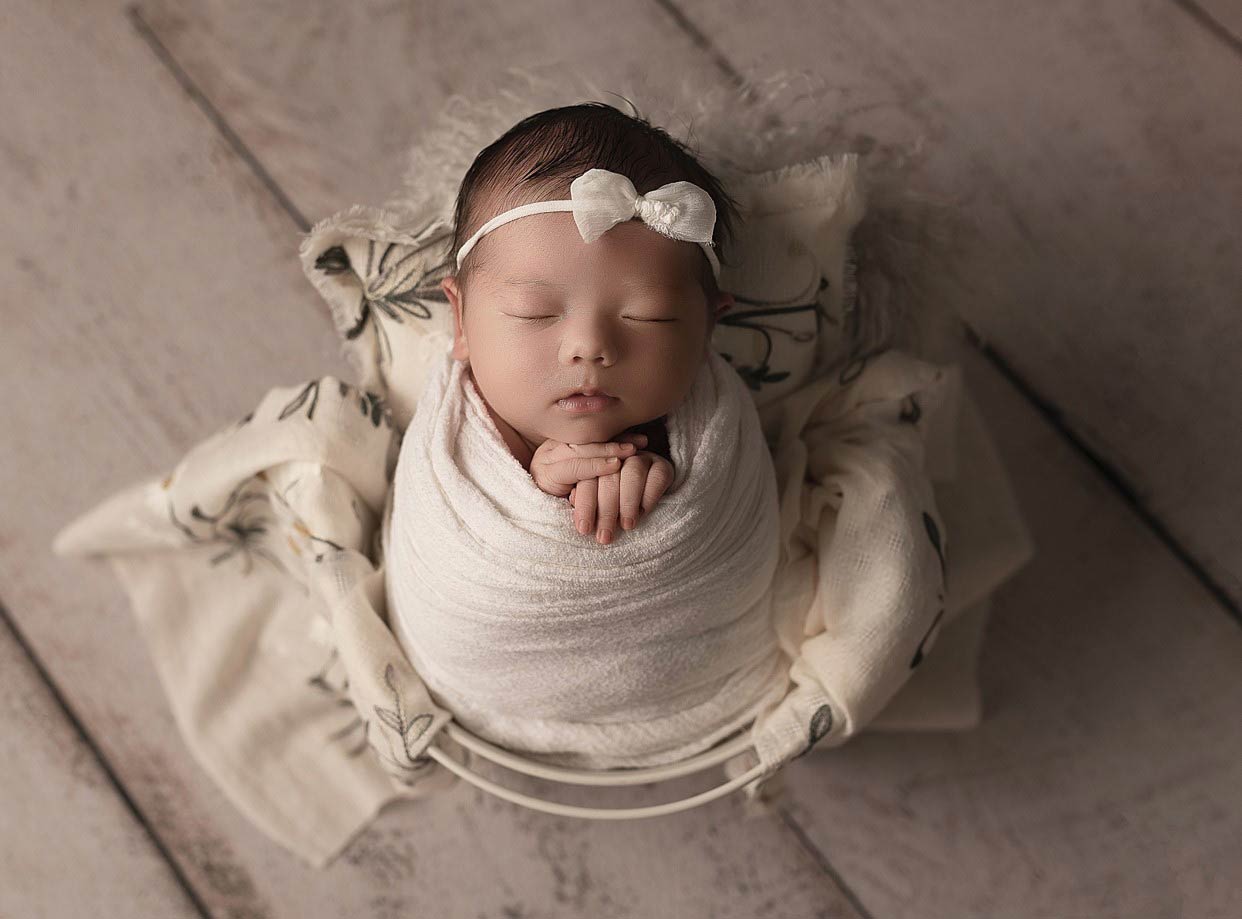
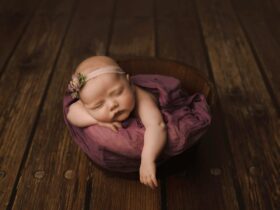
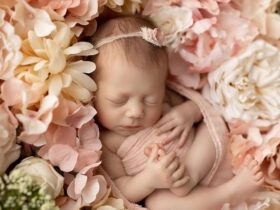
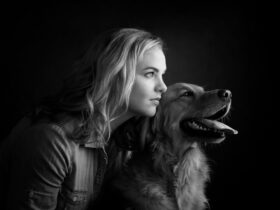
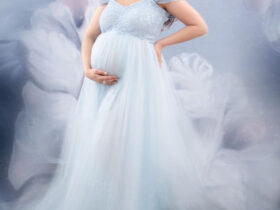
Leave a Review